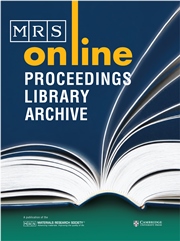Article contents
The Absorption of Diamondoids from Time-dependent Density Functional Calculations
Published online by Cambridge University Press: 23 June 2011
Abstract
Diamondoids are small diamond nanocrystals with perfect hydrogenated surfaces. Recent absorption measurements showed that the spectrum of diamondoids exhibit features that are not understood from the theoretical point of view, e.g. optical gaps are only slightly larger than the gap of bulk diamond which runs against the quantum confinement effect. Previous calcula-tions, even beyond standard density functional theory (DFT), failed to obtain the experimental optical gaps (E g) of diamondoids. We show that all-electron time-dependent DFT (TD-DFT) calculations including the PBE0 hybrid functional in the TD-DFT kernel are able to provide quantitatively accurate results. Our calculations demonstrate that Rydberg transitions govern the low energy part of the absorption spectrum, even for relatively large nanodiamonds result-ing in low E g. Since the optical gap of these diamondoids lies in the ultraviolet spectral re-gion, we investigated whether simple adsorbates of the surface are able to shift the gap towards the infrared region. We found that a double bonded sulfur atom at the surface results in a sub-stantial gap reduction.
Keywords
Information
- Type
- Research Article
- Information
- MRS Online Proceedings Library (OPL) , Volume 1370: Symposium YY – Computational Semiconductor Materials Science , 2011 , mrss11-1370-yy02-07
- Copyright
- Copyright © Materials Research Society 2011
References
REFERENCES
- 2
- Cited by

